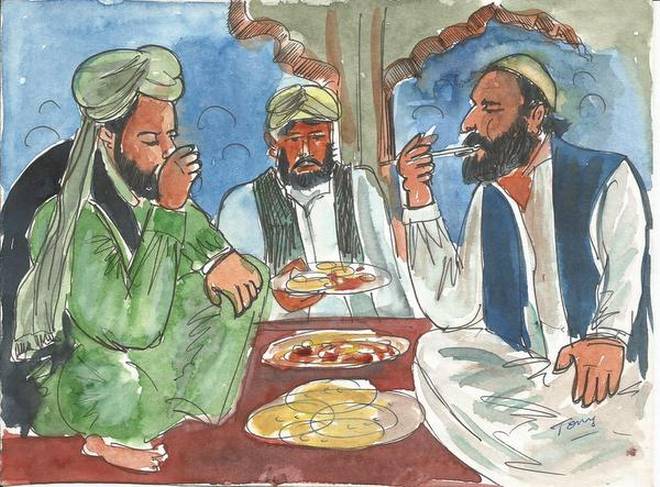A morning communication with my foodie pal Suprapto (call modified for safety) abruptly brought back memories of Kolkata Mughlai delights. Bengalis love Mughlai food like Murg Musallam, Biryani, Mughlai Parota, Rezala, etc. At this time, with an honest urge for food for meals and information, I began going through some Mughal recipe books and the Islamic influence on Indian kitchens when suddenly, my mind was bombarded by questions. But can many of these delicacies, without a doubt, be known as Mughlai?
The crispy paratha parcel with a filling of egg and minced meat is enjoyed with potato sabzi and salad or with meat. In Bengal, it’s miles a completely famous street meal. There is a popular tale of how Emperor Jahangir came behind the invention of the excellent Parantha, and Paranthahe generously rewarded the cook. That equals Parantha because it was parenthesized for the duration of British technology; however, it’s believed that cooks from cutting-edge Dhaka were behind the dish, which has become highly popular as Calcutta street meals.

The Turk-Afghan impact in Bengal goes back to 1205 AD with the navy trendy Bakhtiyar Khalji of Delhi Sultanate. The Turks were gifted three hundred years before Jahangir(1569-1627), and Gözleme, the delicious Turkish avenue food, is just like Mughlai Parantha. Rezala, the mild yogurt-based flavourful dish, is stated to have an Awadhi beginning. Still, in Kolkata, it receives a distinct flavor altogether, and Murg Musallam changed into a great deal found in the Delhi Sultanate. Much of Northern India turned under the Turkish, Afghan, and Middle Asian rule (Slave Dynasty, Khaljis, Tughlaqs, Sayyids, and Lodis) using 1225, and these rulers all stored a delicious kitchen. Ibn Battuta observed the Royal Banquet with roasts, goodies, and dough desserts while the meat cooked with ghee, onion, and inexperienced ginger, halwa, sambusaak, and khichri became had for breakfast.
Noted instructional and food historian Dr. Pushpesh Pant pointed out. “Spices like pepper, galangal, saffron, and pounded almonds were very much present in principal Asian and Delhi Sumealte meal practices. Suspect Britishers had been at the back of the term’ Mughlai.’ They ousted the Mughals and promoted the myth of appearing to be the true successors of the Mughals, and these days, inside the West, ‘Mughlai’ has ended up synonymous with all Indian meals. The proficient baburchis, after the fall of Delhi in 1857, took haven in small states and with their new masters also offered the ‘Mughlai’ myths that are a blended milage of Turko-Afghan meals.”Nowadays, we see pink qormas with chili and grav,h garlic and oi,l and ghee-infused Biryani within the so-called proper shops, which, if appropriate, should shorten Shahjahan’s life partner. I stumbled upon the celebrated ebook of meals historian Salma Yusuf Husain, The Mughal Feast, transcreation of Nuskha-e-Shahjahani, a Persian recipe ebook depicting Shah Jahan’s kitchen. Mughlai delicacies were shaped by various effects (Turkish, Afghani, and Persian) mixed with Kashmiri, Punjabi, and a hint of Deccan.
The Mughals hardly positioned chillily and garlic in their meals, and their temperate use of mild spices like black cumin, dhania, ginger, and black pepper made the meals very soft and delicious. With time, cooking patterns have become more Indianised, and elements like Kashmiri Vadi, sandalwood powder, sugar betel leaf, and white gourd entered the Mughal kitchen. Pulao, within the arms of the Mughals, observed refinement. We pay attention to distinct pulaos like Moti pulao, sarangi pulao, mutant a pulao, and muressrh pulao. Each grain of pulao became lined with the silver war, which aided digestion and acted as an aphrodisiac.
During this time, the Portuguese came with overseas results and vegetables. Abu’l Fazl said each pineapple had been sold for ten mangos. Many culminations were imported. However, in Jahangir’s time, many Central Asian results grew in Kashmir. During his Gujarat campaign, Jahangir was introduced to Khichri and loved it. He also changed into a lot, recognized for his love for fish, and as soon as he was gifted a village with a very good fish cook dinner, Nuskha-e-Shahjahani statistics the names of the grand dishes of Shahjahan’s table.
Aaliyah & Do-piyajah and Kofta Bharta, Biryani & Pulao, Kabab, shiriniha, and different cuisine. When Aurangzeb imprisoned his father, he allowed him the simplest factor of his choice. Shahjahan chose chickpeas. Even today, Shahjahani dal (chickpeas cooked in a gravy of cream) lives in all its glory.


